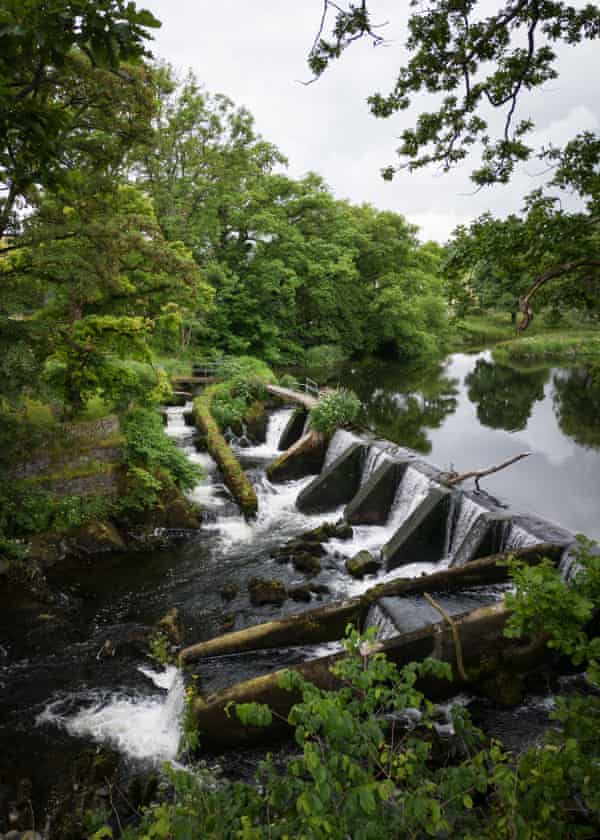
Nearly 150 years after it was built for a paper mill, work has begun to demolish a 3-metre-high weir in Cumbria as part of nationwide efforts to improve biodiversity by allowing fish and invertebrates to move more freely along the UK’s rivers.
Bowston weir lies across the River Kent, an internationally important site of special scientific interest, home to white-clawed crayfish and freshwater pearl mussels, as well as water crowfoot, an oxygenating aquatic plant. But the river is in poor condition due to human interference over the centuries.
Pete Evoy, director of South Cumbria Rivers Trust, said: “Removing Bowston weir will help renaturalise this section of the River Kent, improve navigation for migratory species, reduce flood risks for residents and provide a 44% biodiversity net gain.
“We expect to see more fish, eels, invertebrates and other species,” he said. “It will be the first weir removal on the River Kent but we hope it won’t be the last.”
One of 14 obstacles on the Kent, the 25-metre-wide weir was built in 1874 to control the water flow that powered Bowston Mill, which made rags and rope for the paper industry. The mill closed in the 1960s and was demolished but the weir was left in place.
It has been estimated that there are about 50 to 60,000 dams, weirs and culverts on UK rivers, fewer than half of which are mapped, including barriers built for industry, agriculture and flood defences. Many are now obsolete but continue to block rivers, harming ecosystems.
Bowston is the largest river barrier removal planned for the UK this year. Funded by the European Agricultural Fund for Rural Development, it is expected to take up to three months.

“The Cumbria river restoration strategy aims to remove as many disused weirs as possible and restore natural connectivity in our rivers,” said Oliver Southgate, Cumbria river restoration programme manager for the Environment Agency.
“Bowston weir is one of the largest on the Kent catchment. While the weir already has fish passes, removing the barrier completely will allow all fish species better access to upstream spawning habitat and help restore natural processes on this part of the river, benefiting people and wildlife.”
Getting to the point of removal of Bowston weir was a long, challenging process, said Evoy, which began by gaining agreement from the weir’s owners, James Cropper, which continues to manufacture paper today.
“We obtained approval to progress to removal in 2020, after years of discussions. Local residents were very vocal in their disapproval, due to concerns about perceived flood risk, riparian ownership and concerns that removal would affect local biodiversity.
“The application had to go to a planning committee,” he said, “and was finally approved in February 2022 – five years after the initial feasibility report.”
Last year was a record for dam removals in Europe, with at least 239 dams, weirs and other barriers dismantled across 17 countries, including a dam that has blocked Norway’s Tromsa River for more than 100 years. The recently launched Open Rivers Programme will invest €42.5m (£36.5m) over the next six years in the removal of river barriers across Europe.
But conservationists and river experts are concerned by the slow pace of action in the UK and failure to bring in promised legislation. “We’re frustrated by the current situation,” said Evoy. “Most of these structures were built many years ago; they didn’t consider the environmental impacts they would have.
“In the era of a climate and ecological crisis, weir removals should form part of a nationally supported plan to undo the damage they’ve caused to our rivers.”
Spain removed 108 barriers from rivers in 2021, largely due to legislation that obliges the owner to pay for their removal once they have stopped using it. This kind of legislation is seen as vital to hopes of restoring UK rivers. The Environment Agency pointed to recent improvements to fish passages across England’s rivers, including the Severn and Tyne. But it was unable to provide a timeline for new legislation on removing river barriers.
“Successive governments have been promising legislation to free and restore rivers across the UK for over two decades but have so far failed to deliver,” said Barry Bendall, operations director for the Rivers Trust. “With the considerable decline in our aquatic biodiversity, we urgently need to restore free-flowing rivers.
“But without legislation, there’s very little imperative for the owners of these barriers to do anything about them, so obsolete weirs across the UK will remain in place for generations to come.”
Find more age of extinction coverage here, and follow biodiversity reporters Phoebe Weston and Patrick Greenfield on Twitter for all the latest news and features
Monica has a BA in Journalism and English from the University of Massachusetts and an MS in Journalism and Communications from Quinnipiac University. Monica has worked as a journalist for over 20 years covering all things entertainment. She has covered everything from San Diego Comic-Con, The SAG Awards, Academy Awards, and more. Monica has been published in Variety, Swagger Magazine, Emmy Magazine, CNN, AP, Hidden Remote, and more. For the past 10 years, she has added PR and marketing to her list of talents as the president of Prime Entertainment Publicity, LLC. Monica is ready for anything and is proudly obsessed with pop culture.













